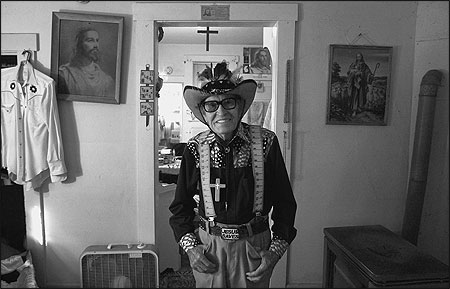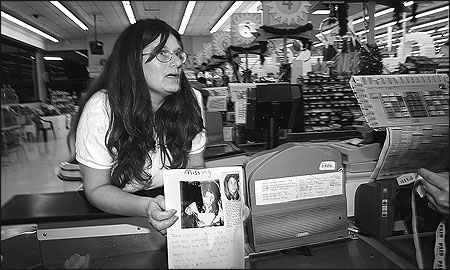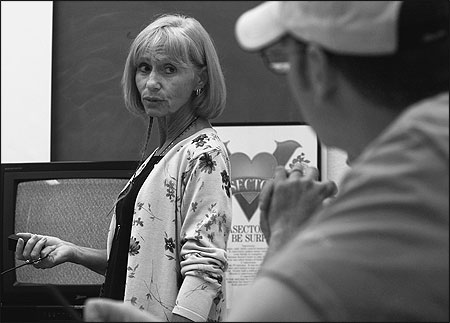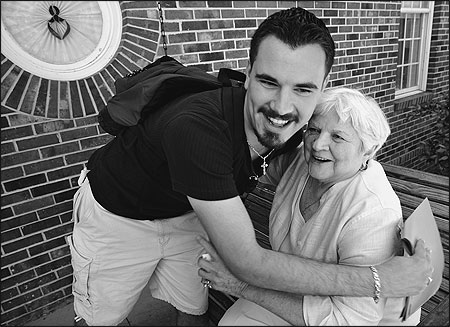
All photos in this series appeared in the St. Petersburg Times and are provided courtesy of the newspaper.In mid-October The Nieman Foundation and The Alliance for Community Journalism, a Boston-based organization that supports locally owned and owner-operated community newspapers, sponsored a community journalism conference for Boston’s neighborhood and community reporters. Lane DeGregory, a feature writer with the St. Petersburg Times, offered tips for these community reporters on how to find people whose stories a local audience would want to read. What follows are edited excerpts from her presentation. 
Tip 1: Elmer Wright. Photo by James Borchuck.
Tip 1: Talk to strangers. Everybody in our community has a story—whether it’s the old lady sitting on a bench or the guy who’s out there feeding the pigeons. Anybody that you see, if you take the time to walk up to EDITOR'S NOTE
Lane DeGregory recieved the 2009 Pulitzer Prize for Feature Writing.them and ask, “What’s your story?,” 99 percent of the time people are flattered you want to know. If you take the time to sit with people and ask them their story, it does make a difference.
I got this story right when I moved to St. Petersburg. We were on this big pier on Tampa Bay and this old man was out there and he was playing the guitar and he was singing and he was really, really bad. And everybody was kind of walking by like, “Oh, my God. Poor man.” So my son goes up and he’s sitting there listening real attentively, and the guy gives him a little red cassette tape. We got back in the car and this tape said, “Elmer Wright, been playing on the pier since 1939.” And I thought, “Gee, that’s longer than I’ve been alive, so I go back to the newsroom and I’m like does anybody know this guy with the Jesus hat and the suspenders who’s out there on the pier?” And they’re like, “Oh, yeah. He’s been out there for years.” No one’s ever written about him. He’s one of those people you just kind of walk by because he’s part of the landscape, and in 47 years no one had written about this guy that they saw up there every weekend.
So I went back the next weekend and I took a photographer with me and we just hung out for a day with Elmer Wright, and we asked him if we could come back to his house.
When I’m reporting a story, I don’t always know what it’s going to be, but I try to think about what could the theme be as I’m talking to this person. What is this a story about? This man’s wife had died when he was a young man. His kids had grown up and moved away. He lived in this little efficiency apartment, and he took his Social Security money and paid to have these little cassettes made of his original songs.
I asked him, “Why do you do this?” This is what he said: “Oh, I know hundreds of people, thousands of people know me. I’m a celebrity, but I’m almost always alone. I had a homeless guy come home with me from the pier one night, but he ate my last can of beans. He drank my Scope. No, I don’t get much company. So when it’s nice out, I play on the pier. You can’t never be lonely on the pier.”
So this was a story about loneliness.
I asked him, “Where do you record these cassettes?” He said, “Come with me and I’ll show you,” and he went in this bathroom and he shut the toilet and he had a boom box on the medicine shelf in his bathroom, and that’s where he made the cassettes. I’m sure there’s an Elmer Wright in every single one of your communities that people have seen that they don’t really know what their story is, and that’s an easy, quick way to do a profile. 
Tip 2: A drag racing daughter. Photo by Bill Serne.
Tip 2: Play hooky. As a feature writer, I’m always feeling like I’m on call. The best stories have come not from my beat or my colleagues or even press releases or PR people; they’ve come out of things in my life. If we take the time when we’re on a field trip with our kids or we’re out to dinner with our husband and we are absorbing what people around us are caring about or talking about, that’s where good ideas for feature stories come from. That’s how we reflect our community, not just what editors assign us to do.
Ride the bus. You have a captive audience—a whole group of people who aren’t necessarily in the same demographic as you are, and they’ve got time. Sit right by them on the aisle, and they’re going to talk to you. Great stories come from walking around docks, public spaces, and by letting somebody else drive. I find stories on my way to work if someone else drives me because if you can check out a different route or take a different way there, there are other things you pass, and then you start to wonder about them.
I left work one day early to go take my son to a car show. He loves the drag racers, and we get there and there’s all these old bubba-looking Florida guys in their drag racers and then there’s this little girl who’s 16 years old and she’s sitting there looking completely miserable and her dad is at this little table saying, “Would you like an autographed picture of my daughter? Come see my daughter, the youngest drag racer in St. Petersburg.” And the girl is like, “Oh, dad.” It was like this typical teenage-dad thing. So I just started talking to him and her and the story was that her mother was dying of AIDS. She’d had a blood transfusion and got AIDS and the parents had been divorced forever and the dad was trying to find a way to connect with his teenage daughter. So as soon as she got her driver’s license, he built her a dragster. She did not want a dragster. Okay? This was like his dream. He worked at an auto body shop, and he was making her drive this dragster on this strip with all these old guys in Florida.
I framed the story around the race: Is she going to win the race? That was sort of the story line, but it was really a story about a father and daughter and a father trying to reconnect with a teenage daughter and the daughter trying to figure out what is it dad wants from me vs. what do I want to do. 
Tip 3: Mother of missing daughter. Photo by Michael Rondou.
Tip 3: Read the walls. This is the most profitable tip I’m going to give you. Small papers, shoppers, classified ads, bulletin boards at laundromats or deli counters and places where people can put up, “Free tuba lessons,” and “We’ll mow your yard.” Those people are easy profiles. Their contact information is there.
This was a story that I got off of a flyer at the laundromat. There was a missing person flyer, and it looked like a lost cat flyer. It was homemade. It was handwritten, and there was a phone number on the bottom. It’s a 14-year-old girl named Tara Exposito, and I called the phone number on the bottom thinking it was the sheriff’s office or the police department, and it was this girl’s mother. She said, “Oh, my gosh. I can’t believe you’re interested in this.” She said her daughter was not a very good kid, she’d been kicked out of school for fighting and smoking pot and drinking and stuff, and she’d run away before, but she had always called her mom and said, “Oh, I’m at Leslie’s house. Mom, I’m okay.” Well, she had been missing for about four weeks and the police were like, “She’s run away. She’s not a victim of anything. She’s just a bad kid who ran away.” They wouldn’t help her look for her daughter. So I spent the weekend before Christmas with the mom as she went to the Publix and the bowling alley and the car wash and just asked people if they’d seen her and hung up flyers all over the place, and there was a profile of the mom.
When I went back and pitched this story to my editor, he’s like, “Lane, there’s 12,000 kids that go missing every year, why should we do a story on this kid?” And I’m like, “Because 12,000 kids go missing every year.” You read about them when they’re dead or when they get brought back home. I’d never read a story about the mom who was out there actively looking for her daughter like that. So I Googled stats and wrote two paragraphs about missing kids and what percentage of them are returned and what percentage of them are dead and what percentage of them the police look for vs. are considered runaways. That was all I had of factoids in my story, but that was enough to float it with my editor that we could do a profile of this mom and the little girl. Sadly enough, she never came home, and they found her body. I had to do a story about nine months later. They still have not solved the murder. 
Tip 4: Man in the freak show. Photo by Scott Keeler.
Tip 4: Make freaky friends. Take a photographer out to lunch, buy a photographer a beer. They have fabulous ideas. At least once a month I’ll find a different photographer and go, “Hey, what are you working on?”
This is a story from a photographer. He was tracing the Tamiami Trail, one of the oldest north-south roads through the state of Florida, and he called me one night on my cell phone about 8:30. He was like, “I’m at the Showtime Bar and Grille in this little tiny town. I’m sitting here having a beer with the fat man and the midget and they’re crying. Do you want to do a story about the fat man and the midget?” I said, “Well, why are they crying?” He said, “Because they’re taking the sideshow on the road for the last time.”
He took some pictures and brought them back and convinced the editor that they should let us go for a whole week to the Allentown County Fair and follow this Florida sideshow on their last trip on the road. It was awesome. This guy had been on the road for 57 years. He had run away to join the circus when he was 12 years old, and he had played Carnegie Hall. I’d seen him when I was a kid at the Smithsonian in D.C.. He played every state, and now the sideshow was dying out, so this story was a profile on him, but it was also about the death of the sideshow.
I was asking him why is it the last time that you guys are going on the road, and he said, “You know what, Lane, you can find fatter people than my fat man at the Ponderosa. You can find tattooed women at St. Pete beach. They’re separating Siamese twins, they’re cutting off the third arm of the three-armed guy, the lizard skin lady has a dermatologist. They’re fixing all this stuff, and so they’re not making freaks anymore.”
I did this great story, hanging out with the people who used to be freaks. They’d been marginalized; they used to be at the beginning of the fair, now they were behind the funnel kicks. 
Tip 5: The dresser for beauty queens. Photo by Kathleen Flynn.
Tip 5: Ignore important people. When I get assigned to do stories about important people, I try to find a way to cover that assignment without going to that person as my source.
This was an assignment about Miss St. Petersburg, who was going to the Miss Florida pageant. She’d been a runner-up for two years in a row, and this was her last year to do this. I was assigned to do a profile on Miss St. Petersburg. She was very pretty and she was very nice, but we’d written about her twice, and she was kind of not that exciting, and I really didn’t want to write a story about Miss St. Petersburg. So I did this thing where I put Miss St. Petersburg in the middle of my circle, and I started thinking about other people who would be connected to Miss St. Petersburg who could be a window into her story or would have some kind of stake in her story that I could tell the story through their eyes instead and satisfy my assignment.
So I started thinking it out. After a few people I thought of didn’t work out—like her mom, who lived too far away, and her personal trainer, who turned out to be secretly dating her, and the pageant caterer, who said no, I started thinking about evening gowns. I hadn’t bought an evening gown since my prom. Where do you go to buy an evening gown? So I called the pageant director and I said, “Where does Miss St. Petersburg go to buy an evening gown?” And she was like, “Oh! Oh, my—we do not let the contestants shop for their own evening gowns. We have a Svengali for that.” And I go, “What?” This 39-year-old gay guy who works at the waffle house, that’s his job. He’s the Svengali. He’s the dresser for the beauty queen pageants, okay? He was so funny and so cool. I called him up, and he started rattling stats at me. He was like a baseball junkie with his stats. He can tell you off the top of his head only one Miss America in the past 14 years has been blond. Texas hasn’t had a Miss America in 28 years. Florida has only had one Miss America, back in 1993.
Not only would he take them shopping, but he would groom them. He would take them back to his house and they’d watch game tapes. “Oh, watch when Miss Delaware dropped her baton, you don’t want to do that. Watch this crazy answer that Miss Texas gave, you don’t want to answer it like that.”
I spent the day shopping with them, and I wrote the story about finding the perfect evening gown for Miss St. Petersburg. The story was about him, and it was so much fun, people totally reacted to him much more than her, and I got out of Miss St. Petersburg, so you can write around them. 
Tip 6: Tampa Bay Buccaneers cheerleader. Photo by Dirk Shadd.
Tip 6: Celebrate losers. We often get sent out to write the story about the person who won the lottery or the guy who made the football team. What about people who don’t make it? I mean what happens when your dream doesn’t come true? Those people are much more rich for profile writing, because they have to regroup and figure out, where do I go from here?
I did a story about the oldest cheerleader for Tampa Bay Buccaneers. She was 38 years old and she had been a cheerleader since she was 18. And she was trying out again, and I just followed her through cheerleading tryouts as she looked at all these girls who were young enough to be her daughter. She didn’t make it, but it was a great ending because she had to go—“Cheerleading is my whole identity. What am I now?” 
Tip 7: Mama V. Photo by Douglas R. Clifford.
Tip 7: Wonder who would ever? Do you remember those Bud Lite commercials where they’d be like, “Here’s to you, Mr. Golf Ball Picker Upper.” “Here’s to you, Mr. Wrestling Costume Designer”? They’re out there in your community, so find out why they do what they do.
I got a story in this bar where little paper coasters say, “For a free vasectomy, call 1-800 blah, blah, blah.” I’m like, who in here is having a Budweiser and they’re going, “Oh, yeah, I think I’d like a free vasectomy.” So I started thinking, who put them there? It’s like Joe’s Bar is now hawking vasectomies. What is the deal with this? So I called the number on the coaster, and this woman who is as old as my mother answers the phone and her name is Flo Conklin and she says, “But they call me Mama V, the mother of vasectomies.” When you get a nickname with somebody, that’s just money. I wanted to know who this person is with a nickname like Mama V. So I talked to Mama V for a little while, and it turns out that she’s a public health nurse for Pinellas County, Florida who had gotten this huge grant to award free vasectomies. They had been trying to give birth control to women and passing out condoms that nobody used, and finally she was like, “I’m going to target a little bit older population and get these men who have had enough kids and try to help them with free vasectomies.”
What sold this story to my editor was my superlative: Pinellas County has more free vasectomies than any county in the whole country. Who knew? She’d wait until 10 or 12 guys had called, then schedule an informational session. She said she’d call me before they did the next informational session. So I went into this room and I’m the only woman with Mama V and then there’s a dozen men in there. I did a narrative of her selling this idea of free vasectomies and these guys trying to go through this process of whether or not they wanted to do it. I found one guy who actually let me follow him through as he had the procedure done, but it was mostly a profile on her—how do you sell free vasectomies? 
Tip 8: Kappa Sig frat mom. Photo by Michael C. Weimar.
Tip 8: Work holidays. I used to dread that, but now I relish it because when you work holidays usually your story is going to go on the front page the next day. And usually people are going to read it the day after the holiday and then go, “I wish I had written that story.” So I take it as a challenge: What am I going to do that’s different for Valentine’s Day? What am I going to do that’s different for Mother’s Day? I try to start thinking far in advance so that I can be the one with that idea.
I did a really fun story for Mother’s Day last year. I found a frat mom who was the Kappa Sig frat mom at the University of Florida, who had like 89 18- and 19-year-old drunk debaucherous guys, and this woman was 80 something years old and she lived in this little room off the foosball table. I spent two days with her because I had to stay for a party one night. She hunkered down in her little room behind all the frat boys.
Holidays and rituals, too, baptisms, funerals, weddings, bar mitzvahs, all of those are built-in narratives because people understand what’s going to happen at a wedding, what’s going to happen at a funeral. You’ve got your narrative structure already built in. When something weird happens, it makes that much more of a surprise.
I did a story that came from a lady who was a PR person from hospice. She kept calling me and wanting me to write stories about their fabulous hospice volunteers, and I was like, “Alright, but you got to find me somebody. I don’t want to just write about the one person that put in the most hours as a hospice volunteer. I need somebody doing something extraordinary, or find me an ordinary person who’s dying who has something that they want to do before they die.” You can kind of train PR people sometimes and tell them what kind of stories you’re looking for or what you like. It took this lady about two years. She finally called me back, she goes, “I think I found somebody for you. This woman is dying of AIDS and she really wants to be baptized before she dies, but she’s Southern Baptist and she wants to be baptized in the full immersion pool.” And none of the churches would do it because of the fear of contamination. So they found this one minister who agreed, and he partnered with the local hospital to come and drain the baptismal pool and baptize her there with all of her family around and then have the hospital sort of disinfect it and take care of it. It was a simple baptism frame, but it was a profile about this woman who, before she died, really wanted to be baptized. 
Tip 9: The fugitive. Photo by Toni L. Sandys.
Tip 9: Be late. I don’t get to cover the news on the day it happens, but I think that a lot of our stories can be more rich, especially profile writing, if you wait a little bit. It’s easier to talk about how it felt to have your kid die two months later than it is the day of the accident.
So I keep a little file on my desk that I pull out of our newspaper and other publications of a news story that happened that I might want to go back on and write about the story behind the story or the effect of that story on that person months or weeks later.
One story I did was off of a police brief, which said “Officer so and so was very happy because after three years of chasing this fugitive, the fugitive turned himself in at 11:30 p.m. last night to the Hillsborough County Sheriff’s office.” This detective had been looking for this guy and I started thinking about that and I was just thinking about this guy who was a fugitive for three and a half years. Why would he turn himself in? There was nothing else about it in the police brief, so I waited maybe about two weeks and I wrote a letter to the fugitive who was in jail and I just told him I was interested in his story and why would he turn himself in, and he called me collect the very next day and said, “I’d love for you to come and talk to me.”
I did this big profile on him. My first question was, “How do you be a fugitive? How do you do that?” He says he was a 38-year-old stockbroker. He went out for his birthday, got drunk with his friends, driving home he plowed through these three Army officers on the way home and killed them, a DWI manslaughter. He was facing life in jail, so he bailed himself out, waited for his trial, and the night before his trial he throws this huge party for himself and he just drives away into the sunset. He didn’t even drive, he got on the bus. Left his car, left his dog, left his girlfriend, didn’t tell his parents or any of his friends where he was going, just hit the highway on the Greyhound bus and landed in Pennsylvania, was working as a telemarketer, changed his name, spent three and a half years, never contacted anybody from his old life. And one night he’s chain-smoking Marlboros on the bed in this little Econo Lodge where he’s staying, watching TV, and he sees himself on “America’s Most Wanted” and he’s like, “I got to go back. I don’t want to live like this for the rest of my life.”
So I profiled this fugitive, and this probably ran maybe a month or so after that cop brief saying they had caught the guy, but it was totally the other side and it was because I waited until after the news part had happened. Then he was able to tell me his story.
Tip 10: Hang out at bars. Even if you don’t drink, bars are the greatest place in the world to get stories, because everybody in bars is telling stories and nobody ever minds at a bar when you go, “Hey, I heard you—what was that story you were telling?” It’s great to have a place like Cheers where you can come back and everybody knows who you are. I leave a stack of my business cards with my favorite bartender, and she finds stories for me. I’ll come back in, and she’ll go, “Lane, I met this guy. I told him all about you and here’s his information.” She’s out there brokering stories for me.
I get lost sometimes in the quirkiness and have to come back to reality and say, “Okay. Now how am I going to pitch this to my editor?” The most extraordinary looking people, like the Elmer Wrights of the world, I’ll try to find out the most normal thing about them. What makes them human like all the rest of us? We look at this guy and we go, “Oh, that is a weirdo.” But we’ve all experienced loneliness or a need to belong somewhere. So I try to think about my stories in a two-or three-word theme. What is this story about? With the woman who was looking for her daughter, it was about loss and regret. With the woman who wanted to be baptized before she died, it was about salvation. Try putting a one-word or two-word label of what your story is about, and this will kind of help you focus and figure out what is universal in this story.


